Related Research Articles
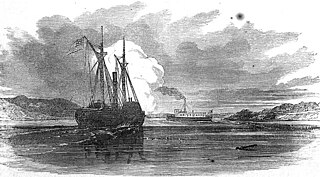
A tugboat or tug is a marine vessel that manoeuvres other vessels by pushing or pulling them, with direct contact or a tow line. These boats typically tug ships in circumstances where they cannot or should not move under their own power, such as in crowded harbors or narrow canals, or cannot move at all, such as barges, disabled ships, log rafts, or oil platforms. Some are ocean-going, and some are icebreakers or salvage tugs. Early models were powered by steam engines, which were later superseded by diesel engines. Many have deluge gun water jets, which help in firefighting, especially in harbours.

A merchant ship, merchant vessel, trading vessel, or merchantman is a watercraft that transports cargo or carries passengers for hire. This is in contrast to pleasure craft, which are used for personal recreation, and naval ships, which are used for military purposes.

Anchor Handling Tug Supply (AHTS) vessels are mainly built to handle anchors for oil rigs, tow them to location, and use them to secure the rigs in place. AHTS vessels sometimes also serve as Emergency Response and Rescue Vessels (ERRVs) and as supply transports.

A salvage tug, known also historically as a wrecking tug, is a specialized type of tugboat that is used to rescue ships that are in distress or in danger of sinking, or to salvage ships that have already sunk or run aground.
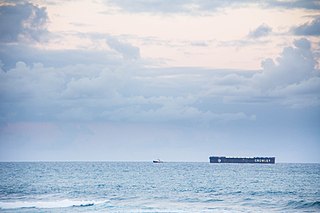
Crowley, legally Crowley Maritime Corporation, is based in Jacksonville, Florida. Founded in 1892, Crowley is primarily a family- and employee-owned vessel management, owner, and supply chain logistics services company, providing services globally. As of July 2016, Crowley was ranked as the 13th largest private company in Florida, employing approximately 5,300 people worldwide with revenues of $2.2 billion. It provides its services using a fleet of more than 300 vessels, consisting of RO-RO vessels, LO-LO vessels, tankers, Articulated Tug-Barges (ATBs), tugs and barges. Crowley's land-based facilities and equipment include terminals, warehouses, tank farms, and specialized vehicles.

SS Foundation Franklin was a seagoing salvage tug built for the Royal Navy as HMS Frisky in 1918. In 1924, the tugboat was sold and renamed Gustavo Ipland before being acquired in 1930 by Foundation Maritime and renamed Foundation Franklin. The tugboat became famous for many daring salvage operations and rescues between 1930 and 1949. Her many rescues and salvage triumphs were celebrated in Farley Mowat's book The Grey Seas Under. In 1948, the ship was damaged in a hurricane and not considered repairable. The tug was broken up for scrap in 1949 at Halifax, Nova Scotia.
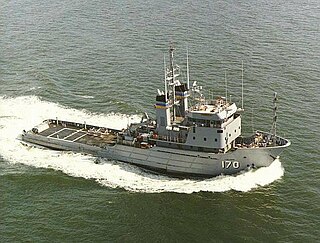
USNS Mohawk (T-ATF-170) was a United States Navy Powhatan-class tugboat operated by the Military Sealift Command from 1980 to 2005.

CFAV Firebird was a Fire-class fireboat in the Royal Canadian Navy designed by Robert Allan Ltd. Firebird was based in CFB Halifax, in Halifax, Nova Scotia. Her sister ship CFAV Firebrand is based in CFB Esquimalt.
Kitano was a Japanese container ship. She was delivered in Japan in 1990 to Japanese container line NYK and scrapped in China in November 2011.
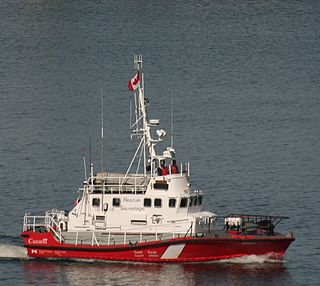
CCGS Sambro is a Canadian Coast Guard motor lifeboat homeported in Sambro, Nova Scotia.

MV Camilla D was a St Kitts and Nevis cargo vessel that has operated since 2003 in the waters of eastern and Arctic Canada. Before that, the ship was sailing under the Finnish flag as MS Camilla, owned by Lundqvist Rederierna of Mariehamn, Åland Islands. The ship was built by Krögerwerft GmbH in Rendsburg, West Germany in 1982. As the ship operated out of Finnish and Baltic ports in winter mainly without icebreaker assistance, she has the highest Finnish-Swedish ice class of 1A Super. The vessel was beached May 28, 2022, at Alang for demolition.
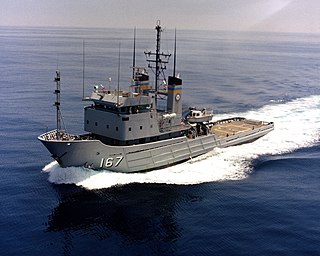
USNS Narragansett (T-ATF-167) is a Powhatan-class fleet ocean tugboat of the US Navy. She was launched in 1979 and inactivated in 1999, but has since been employed in a number of roles. She is still in service as of 2023 as a training support vessel for Carrier Strike Group 4.

An emergency tow vessel, also called emergency towing vessel, (ETV) is a multi purpose boat used by state authorities to tow disabled vessels on high seas in order to prevent dangers to man and environment. The disabled vessel is either towed to a safe haven or kept in place against wind and current until commercial assistance by tug boats has arrived on site or until it has been repaired to the extent of being able to manoeuvre on its own. The need for ETVs as a preventive measure has arisen since the number of available commercial salvage tugs was reduced while potential dangers from individual vessels have increased. E.g. Spain has fourteen, Turkey has eleven, Germany operates eight, Norway has seven, France has five, Sweden three and the Netherlands, Poland, South Africa, Iceland and Finland each have one official emergency tug boat. Australia also operates emergency response vessels. The United Kingdom's four strong ETV fleet was to be disbanded in September 2011 due to budget cuts but the two vessels operating in Scottish waters received an extension of contract until the end of 2011.

CCGS Earl Grey is a Samuel Risley-class light icebreaker and buoy tender in the Canadian Coast Guard. Constructed in 1986, the vessel serves a variety of roles, including light ice-breaking and buoy tending, as well as being strengthened for navigation in ice to perform tasking along the shores off the Atlantic coast of Canada. Like her sister ship, CCGS Samuel Risley, she carries a large and powerful crane on her long low afterdeck for manipulating buoys. Earl Grey is the second icebreaker in Canadian service to carry the name.

USNS Navajo (T-ATF-169) was a United States Navy Powhatan-class tugboat operated by the Military Sealift Command which was in service from 1980 to 2016. She spent the bulk of her career in the Pacific and is currently moored in Pearl Harbor, awaiting disposal.

USNS Powhatan (T-ATF-166) was the lead ship of the United States Navy Powhatan-class fleet ocean tugboats. She was in service with the U.S. Navy from 1979 to 1999, and then was leased to a private towing and salvage company. At the end of the lease in 2008, the ship was sold to the Turkish Navy which recommissioned her as TCG Inebolu.

USNS Sioux (T-ATF-171) was a United States Navy Powhatan-class tugboat operated by the Military Sealift Command (MSC). She was in service from 1981 to 2021 and spent the bulk of this time supporting the Pacific Fleet.

The Powhatan class of fleet ocean tugs consists of seven ships built for the United States Navy, and operated by the Military Sealift Command (MSC). The lead ship of the class was launched in 1978 and the last ship in MSC service will be deactivated in 2023. During their service life, the Powhatan's were the most powerful tugs owned by the Navy.
MT Phoenix was a tanker which went aground in heavy seas at Sheffield Beach just north of Ballito near Durban, South Africa on the morning of 26 July 2011. The vessel was on its way to India to be scrapped when it ran aground. After three attempts, it was refloated, towed and then scuttled and sunk in 2,000 metres (6,600 ft) of water, about 80 kilometres (43 nmi) offshore of Amanzimtoti, south of Durban. The vessel was reportedly owned by either Suhair Khan of Dubai or Marika Investments, Lagos, Nigeria.
References
- ↑ "DP Ocean Going Tug/Field Support Vessel/ROV - RYAN LEET" (PDF). Secunda Canada LP . Retrieved 2008-02-13.
- ↑ "Ryan Leet". Canadian Transportation Agency. March 8, 2006. Archived from the original on July 6, 2011. Retrieved 2008-02-13.
- ↑ Jeff Cameron (March 23, 2002). "Ryan Leet". WellandCanal.ca. Retrieved 2008-02-14.
- ↑ "Marine Investigation Report, Container Fire, Container Vessel Kitano, Off Chebucto Head, Nova Scotia, 22 March 2001" (PDF). Transportation Safety Board of Canada. 28 January 2003. Archived from the original (PDF) on 8 November 2005. Retrieved 2008-02-13.
- ↑ "Marine Investigation Report, Container Fire, Container Vessel Kitano, Off Chebucto Head, Nova Scotia, 22 March 2001: Summary". Transportation Safety Board of Canada. 28 January 2003. Archived from the original on 25 November 2005. Retrieved 2008-02-13.
- ↑ "Titan / ITC Rescue Abandoned Ro Ro". Marcon . Retrieved 2008-02-10.
- ↑ "Lake Carling update - Lloyd's List & canoe.ca". WellandCanal.ca. March 20, 2002. Retrieved 2008-02-10.